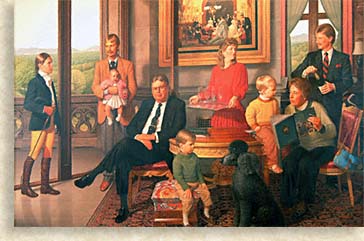
William A. V. Cecil Family by Stone Roberts, 1990-91
[a complete view of the photo is on the bottom right of this link] http://www.biltmore.com/our_story/our_history/vanderbilt.asp
In the 1800s the Vanderbilt family was known for their wealth. George Vanderbilt loved traveling, which led him to the mountains of Asheville, North Carolina, to discover the location of his future home, and America’s largest home today. Stone Roberts created the William A.V. Cecil Family Portrait in 1990-91. The Cecils now run the business of allowing tours in their ancestor’s mansion. Robert’s use of light and his sitter placement, generate a curious façade of family focus.
When entering the Biltmore Estates and seeing this family portrait hung high, the question of lighting would arise. When the family is positioned in front of two, rather large, windows during the daylight, and an additional bright light is hung over the Vanderbilt family portrait from the 1800s, why is this necessary? Is this an attempt to reveal the parallel in family communion? Possibly emphasizing on the family success? Accentuating the importance of the “privileged minority” that can “justify the role of the ruling classes” by inviting all people into their home?
Social issues are the focal dialogue of this painting in relation to the past and present. Mystification tries in a bold fashion to cloud the intent of Robert’s work. Though the room is not endowed with more than a rug, painting, table, and chairs, the Cecil’s personas portray sophistication. For example, the sitters are exemplifying the enjoyment of riding, reading, an elite pet, drinking wine during the day, and wearing fashionable clothing in a casual environment. The Vanderbilt and Cecil family portrait, both being displayed in one painting, centered on family bonding, was a well-planned attempt to convey irony. However, the picture doesn’t have me convinced that love is the common ground with this family, I feel the commonality is in a name: Vanderbilt, also known as wealth.
Taking a second glance to find more than the obvious things in a painting can powerfully impact your perspective. I learned that it is disrespectful to the artist and myself, to simply overlook their details and be deprived of the message that yearns to be shared with me.
My dialogue with Robert’s work has confirmed Berger’s expectations of optimal seeing. Everyone can achieve the task of exercising artistry. As a result of history’s perpetuation, understanding and appreciating art has been perceived as a privileged practice. However, “seeing” is the only aid needed for appreciating and developing an opinion regarding a painter’s work. An individual’s divine right is the entitlement to perspective.
Nice job with this first blog--hopefully this process will help you draw deeper meanings out of your image collection for essay #1.
ReplyDelete30/30
VS